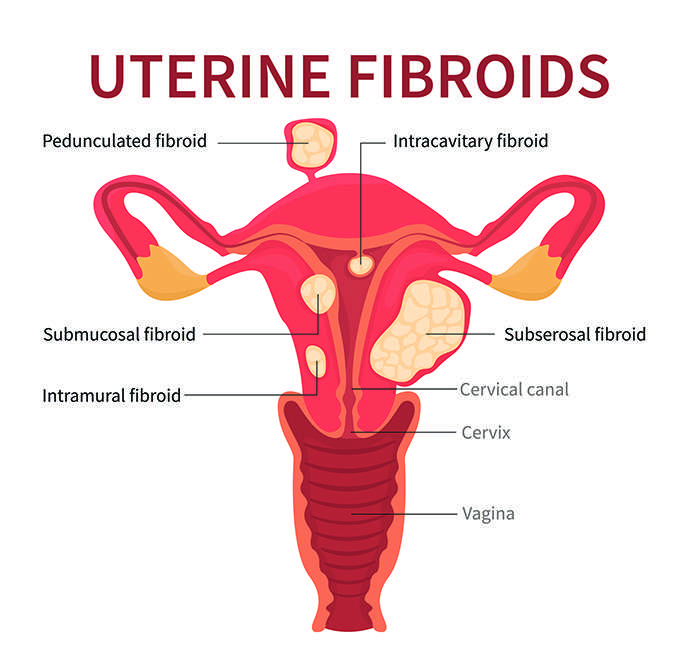Different types of uterine fibroids

Uterine fibroids, also known as leiomyomas or myomas, are benign (non-cancerous) growths that develop in the muscle wall of the uterus. They are very common, affecting up to 80% of women by the time they reach menopause.
Not every uterine fibroid (UF) is the same. There are actually several different types that a person can be diagnosed with, and they vary based on their location within the uterus. By learning about each type of uterine fibroid, you can understand how they affect the body and the best ways to treat them, such as uterine fibroid embolization.
There are 4 main types of uterine fibroids, based on their location:
- Intramural fibroids:These fibroids grow within the muscle wall of the uterus. They are the most common type of fibroid, accounting for about 70% of cases.
- Submucosal fibroids:These fibroids grow into the uterine cavity. They are less common than intramural fibroids, but they can cause more bothersome symptoms.
- Subserosal fibroids:These fibroids grow on the outside of the uterus. They are the least common type of fibroid, but they can grow large and cause pressure symptoms.
- Pedunculated fibroids — These fibroids are attached to the uterine wall by a peduncle, which is a thin stem-like growth. Pedunculated fibroids can develop inside and outside of the uterus. They are often considered a variation of submucosal or subserosal fibroids.
In addition to these 4 main types, there are also a few other less common types of uterine fibroids, including:
- Cervical fibroids:These fibroids grow on the cervix, the neck of the uterus.
- Multiple fibroids:Many women have multiple fibroids at the same time.
The two most common types are intramural and subserosal fibroids.
The type of uterine fibroid a woman has can affect the symptoms she experiences. For example, submucosal fibroids are more likely to cause heavy menstrual bleeding, pelvic pain, and difficulty getting pregnant. Subserosal fibroids are more likely to cause pressure symptoms, such as urinary frequency, constipation, and back pain.
Here is a more detailed overview of the different types of uterine fibroids:
- Intramural fibroids – Intramural fibroids are the most common type of fibroid. They are usually small and cause no symptoms. However, larger intramural fibroids can cause heavy menstrual bleeding, pelvic pain, and pressure symptoms.
- Submucosal fibroids – Submucosal fibroids grow into the uterine cavity. They are less common than intramural fibroids, but they can cause more bothersome symptoms. Submucosal fibroids can cause heavy menstrual bleeding, pelvic pain, difficulty getting pregnant, and miscarriage.
- Subserosal fibroids- Subserosal fibroids grow on the outside of the uterus. They are the least common type of fibroid, but they can grow large and cause pressure symptoms. Subserosal fibroids can cause urinary frequency, constipation, back pain, and pain during sex.
- Pedunculated fibroids- Pedunculated fibroids are attached to the uterus by a stalk. They can grow large and twist, causing pain. Pedunculated fibroids can also detach from the uterus and move into the abdomen, where they can cause serious complications.
- Multiple fibroids- Many women have multiple fibroids at the same time. This can make symptoms more severe and make treatment more challenging.
How United Fibroid & Vascular Centers Can Help Every Type of Uterine Fibroid
If you’re experiencing symptoms from your uterine fibroids, it’s important to treat them for an improved quality of life and healthier future. Regardless of what type of uterine fibroid you have, you may benefit from uterine fibroid embolization, or UFE. This is a minimally invasive procedure that is an alternative option to a hysterectomy.
Uterine fibroid embolization shrinks or eliminates the fibroids by cutting off their blood flow. Many people experience quick results, allowing them to quickly return to their regular activities with reduced symptoms.
If you’re ready to explore a safe and effective uterine fibroid procedure, it’s time to schedule a consultation with us.
Speak to a dedicated patient specialist today.
Call Toll-Free 813-445-4707
90% of women have a positive resolution of fibroid related symptoms after their UFE treatment.
Our vascular board-certified physician will discuss with you whether UFE is a good treatment option for you taking into account your lifestyle, type, size, and position of the fibroids, and any risks they may present.
